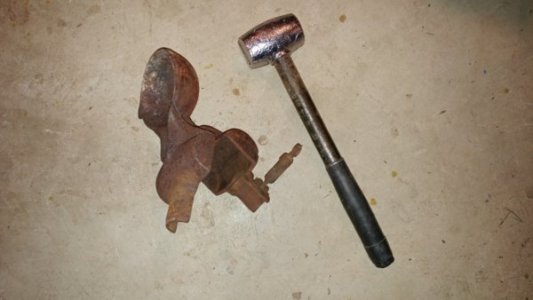I have a stash of lead from various sources including a 5 gallon bucket of wheel weights. If you befriend the local garage, you can often get wheel weights for free.
I make jigs and sinkers for fishing and usually do one or two pours a year. I made my pot by welding some 1/4 plate on one end of a short length of 4" steel pipe. A couple of loops for eyes and some 3/6" rod for a handle and I have a very serviceable pit that I have been using for the last 30 years. I bought a ladle back when plumbers still poured the lead and oakum joints for cast iron pipe. The hardware store probably doesn't stock them any more but they are available on line. For a furnace, I use a propane fired camping stove. To concentrate the heat, I made a chimney from a large coffee can that fits over my kettle.
I dug out my hammer mold. I have needed to remake my hammer for some time. The mold is hinged and meant to use 1/2" pipe for the handle. The mold has a built-in ladle to simplify casting. The mold is hinged and a small clamp keeps the mold closed during the casting process. My handle has the pipe threads on the end and a common nail inserted through cross drilled holes. The end of the pipe is stuffed with insulation to prevent the molten lead from running down the handle. The casting is made by tilting the mold so the molten lead runs from the ladle into the mold. The mold will cast a 3 lb. hammer. It took about ten minutes start to finish to cast the hammer.
I am not too concerned about lead vapors. The boiling point of lead is almost 3000ºF. Unless you were using something like an oxyacetylene torch as a heat source, the likelihood of having lead vapors in the atmosphere is pretty small.
View attachment 239648


